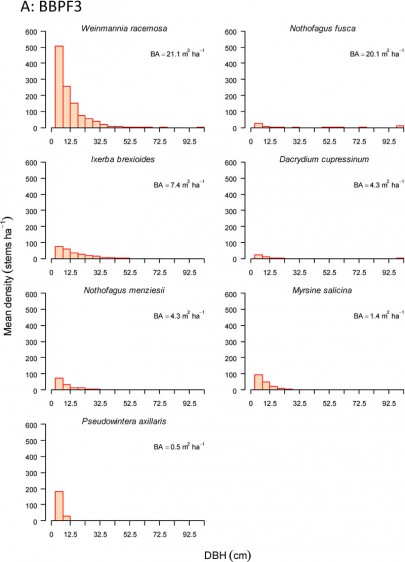Weinmannia racemosa - Cyathea smithii - Prumnopitys ferruginea / Blechnum discolor forest
In this section
Common name: Kāmahi forest
Code: A: BBPF3
Where does it occur?
This 371 000 ha alliance was sampled only on the South Island west coast north of 43°S and on the North Island south of 37°S. It occurs from sea level to 700 m on the South Island and from 300–1100 m on the North Island.
Description
The forest is dominated by Weinmannia racemosa, Prumnopitys ferruginea and Cyathea smithii, with Blechnum discolor commonly dominating the understory. Dacrydium cupressinum may be co-dominant. Diagnostic species include Pseudowintera axillaris, Myrsine salicina and Ixerba brexioides. The climber Metrosideros diffusa is frequent.

A: BBPF3. Size Structure of canopy dominants.
In the ground layer important species are Asplenium flaccidum, Grammitis billardierei, Astelia solandri, Microlaena avenacea, Microsorum pustulatum, Hymenophyllum demissum and Uncinia uncinata. Species richness is moderate with on average 51 species per plot, with more than half of these (26) being measurable trees. Ferns are important in this forest class, comprising on average 36% (18) of the species.Exotic species richness is low (mean = 0.4 per plot, range 0–4) and no individual species is particularly frequent.
Indicator species
Co-occurrence of Blechnum discolor, Myrsine salicina, Pseudowintera axillaris and Weinmannia racemosa.
Stand characteristics
| Mean canopy height (m): | 17 m (range 2–32) |
| Mean stem density (stems/ha): | 3741 (374) |
| Mean basal area (m2/ha): | 85 (4.8) |
Synonyms
| Relationship | Name | Author |
|---|---|---|
| overlaps with | Kamahi broadleaved podocarp forest | Singers & Rogers (unpublished) |
| includes | Kamahi, tawa, podocarp, beech forest | Singers & Rogers (unpublished) |
| overlaps with | Conifer/broadleaved forests of lower altitudes: Taranaki to the Marlborough Sounds | Wardle (1991) |
| overlaps with | High-altitude conifer/broad-leaved forests: Southern North Island | Wardle (1991) |
Component associations
Weinmannia racemosa – Prumnopitys ferruginea / Myrsine salicina – Pseudowintera axillaris – Cyathea smithii / Blechnum discolor forest
Common name: Kāmahi – miro – toro – lowland horopito forest with crown fern
Code: a: OF4
Where does it occur?
This association has been sampled only from the Tararua Range of the North Island. Sites range from flat to very steeply sloping (55º). Altitudes range from 190 to 900 m.
Weinmannia racemosa – Prumnopitys ferruginea / Pseudowintera axillaris – Myrsine salicina – Cyathea smithii forest
Common name: Kāmahi – miro – lowland horopito forest – toro
Code: a: BLP12
Where does it occur?
This 60 500 ha association has been sampled from East Cape, Taranaki and the Tararua & Rimutaka Ranges. Sites range from flat to steeply sloping (39º). Altitudes range from 220 to 840 m.
Description
This forest association is, on average, 14 m tall but can range widely from 2 to 30 m. It tends to be species-rich with an average of 49 species on a plot which can range from 23 to 75. On average, there are very few (less than 1%) exotic species present.
References
Wiser, S.K., Hurst, J.M. 2010. Composition and structure of 24 New Zealand forest and shrubland vegetation communities. Landcare Research Contract Report LC0910-073. Prepared for the Department of Conservation and the Sustainable Management Fund of the Ministry of Agriculture and Forestry.
Wiser, S.K., J.M. Hurst, R.B. Allen, E.F. Wright. 2011. New Zealand’s forest and shrubland communities: a classification based on a nationally representative plot network. Applied Vegetation Science 14: 506-523.
Wiser, S.K.; De Cáceres, M. 2013. Updating vegetation classifications: an example with New Zealand's woody vegetation. Journal of Vegetation Science 24: 80-93.
De Cáceres M, Legendre P, Wiser SK, Brotons L (2012) Using species combinations in indicator value analyses. Methods in Ecology and Evolution 3(6): 973-982.



